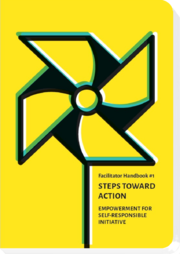|
|
| Line 1: |
Line 1: |
| | <div class="teaser-text">In our work on voluntary project management with youngsters and young adults across Europe, we are often confronted with strong negative opinions and reactions among learners. As these negative thoughts often come from within, participants often need support in dealing with them.</div> | | <div class="teaser-text">In our work on voluntary project management with youngsters and young adults across Europe, we are often confronted with strong negative opinions and reactions among learners. As these negative thoughts often come from within, participants often need support in dealing with them.</div> |
| − | <div style="float:left; width:18%; "> | + | <div class=methodpage-infos> |
| − | <hr style="border:0; border-bottom: 1px dashed #d21e3d; width: 100%;"> | + | <hr class=simpleline> |
| | [[File:Time-icon.png | 20px | Time]] 40 minutes | | [[File:Time-icon.png | 20px | Time]] 40 minutes |
| | | | |
| Line 11: |
Line 11: |
| | | | |
| | [[File:Keywords.png | 20px | Keywords ]] motivation, reflection, criticism | | [[File:Keywords.png | 20px | Keywords ]] motivation, reflection, criticism |
| − | <hr style="border:0; border-bottom: 1px dashed #d21e3d; width: 100%;"> | + | <hr class=simpleline> |
| − | '''Related:'''
| + | ===Related:=== |
| | * [[Active Citizenship Education]] | | * [[Active Citizenship Education]] |
| | | | |
| − | <hr style="border:0; border-bottom: 1px dashed #d21e3d; width: 100%;"> | + | <hr class=simpleline> |
| | <div class=left-box> | | <div class=left-box> |
| | '''Handbook #1<br>Steps toward action''' | | '''Handbook #1<br>Steps toward action''' |
| Line 26: |
Line 26: |
| | </div> | | </div> |
| | </div> | | </div> |
| − | <div style="float:right; width:80%; border-left:1px dashed #ff0000; padding-left:20px;"> | + | <div class=methodpage-content> |
| | ==Goals== | | ==Goals== |
| | * Participants reflect their way of internal criticism | | * Participants reflect their way of internal criticism |
| Line 105: |
Line 105: |
| | *M. Gawinek-Dagargulia, E. Skowron, N. Zimmermann (Ed.): [http://competendo.net/en/Handbooks_for_Facilitators Steps toward Action; Empowerment for self-responsible initiative; Help your learners to discover their vision and to turn it into concrete civic engagement]; Facilitator Handbook #1; MitOst Editions 2016 | | *M. Gawinek-Dagargulia, E. Skowron, N. Zimmermann (Ed.): [http://competendo.net/en/Handbooks_for_Facilitators Steps toward Action; Empowerment for self-responsible initiative; Help your learners to discover their vision and to turn it into concrete civic engagement]; Facilitator Handbook #1; MitOst Editions 2016 |
| | </div> | | </div> |
| | + | __NOTOC__ |
In our work on voluntary project management with youngsters and young adults across Europe, we are often confronted with strong negative opinions and reactions among learners. As these negative thoughts often come from within, participants often need support in dealing with them.
 40 minutes
40 minutes
 copied template and pens
copied template and pens
 5-30 people
5-30 people
 mgd/K. Dorota
mgd/K. Dorota
 motivation, reflection, criticism
motivation, reflection, criticism
Related:
Handbook #1
Steps toward action

M. Gawinek-Dagargulia, E. Skowron, N. Zimmermann
First handbook of our Handbooks for Facilitators: Read more
Goals
- Participants reflect their way of internal criticism
- They become familiar with a preventive technique for limiting it
Steps
Introduce five different types of internal criticism.
|
Doubts
|
Reactions
|
This is a bad idea
|
Constructive criticism in the form of a proposal: "And what would your alternative to that be?"
|
People will not like it
|
Combating generalizations and making them more concrete: "Whom exactly do you mean?"
Showing different perspectives: "Do you know people who will like it?"
|
Others did it already
|
Relevance is more important than innovation: "Change isn’t always about bright new ideas; an idea must be relevant for people."
|
Others will do it better
|
Use good experience: '"Learn from others."
Feed forward: "Imagine a situation in which you already did something similar in a successful way - how did you deal with it then?"
|
I am not the manager type
|
Bring it on the level of small steps: "What realistic first steps could you take with your competencies and capacities?"
|
2. Ask your participants or your mentee/student to imagine past situations where they felt this inner criticism. What helped them to overcome it?
3. Which argument is typically for the person? How does the here proposed reaction sound?
4. Develop a personal motivational motto in pairs:
Let your participants choose a disturbing label. Then make them break the statement into “simple pieces” by trying to find logical foundations for it. If participants conclude that the statement simply isn’t rooted in reality, they can create a new sentence, statement, or a rule that constructively motivates them. This is very helpful in the process of tracking down what they really want, and what fuels their “inner fire.”
The list can be long and filled with any kind of potential doubt. Writing these doubts down and giving them names brings relief in and of itself.
Experience
A very successful method for dealing with such labels by changing them into positive affirmation, which then motivates us and pushes us toward action.
Source

